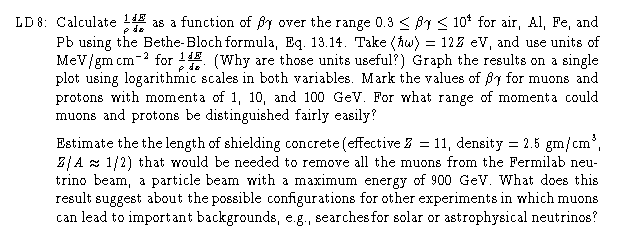 |
|
Comments: Take Z/A = ½.
The dE/dx curves are important in many areas, for example,
radiological physics where one may be interested in shielding with respect
to radioactive sources, or in energy deposition in tissue as a hazard or in
treatment of cancer using particle beams.
The estimate of the length of shielding made in the second part of the
problem is an underestimate. dE/dx is decreased for highly relativistic
particles by the density effect.
Radiative energy loss in close collisions also becomes important at the
highest energies. While this increases the average dE/dx, so decreases
the average range of the particles, the radiative energy loss is subject to
significant statistical fluctuations. In particular, the
number of close collisions made by a particle in traversing a slab of
matter is Poisson-distributed about the mean number. A small fraction
of the muons in a monoenergetic beam will therefore have significantly
fewer close collisions than the average, lose less than the average amount
of energy in radiative processes, and continue to penetrate the shield
until their energy is absorbed by ionization. The
estimate of the shielding needed, with the density effect taken into account
but radiation ignored, is therefore reasonable. See the Review of Paricle
Properties, Phys. Rev. D 54, 132 (1996) for a complete discussion
of the passage of particles through matter.
|
 for both the monopole and for a nucleus with
equivalent energy loss for for velocities v ~ 1. Describe how you could
use the difference for v << 1 to distinguish the particles.
for both the monopole and for a nucleus with
equivalent energy loss for for velocities v ~ 1. Describe how you could
use the difference for v << 1 to distinguish the particles.
